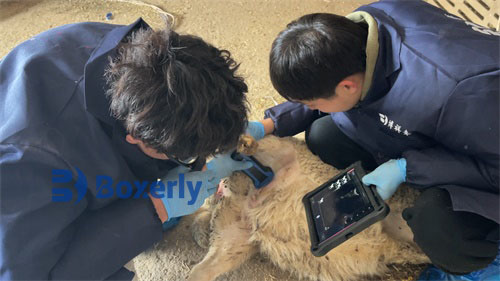In order to meet the real-time display of veterinary B-ultrasound video, the module adopts a ping-pong mechanism with a dual frame memory structure, and the FPGA implements read-write interlock control. After the veterinary B-ultrasound video is converted by A/D, it is processed in the FPGA for logarithmic compression, exponential transformation, echo amplitude depth correction, line correlation and frame correlation, and then alternately written into frame memory A and frame memory B. The frame memory read controller reads the data in the frame memory according to the back-end processing speed and sends it to the DMA channel for data transmission. When the FPGA implements read-write control, in order to avoid reading and writing a frame memory at the same time, it is necessary to set a read-write mutex lock to switch the memory state.
Veterinary B-ultrasound
The number of scan lines of the veterinary B-ultrasound video image collected by the system is 256 lines/frame, the sampling rate is 1024 pixels per line, and the pixel grayscale is 256 levels. Then, the storage required to store a frame of image is 256KB. In the entire veterinary B-ultrasound diagnostic instrument system, when doing frame correlation and back-end image processing, we do it in frames, so when selecting memory, we mainly consider capacity and speed. The entire veterinary B-ultrasound acquisition system needs to use a memory for frame-related processing and two memories for ping-pong processing. These three memories can store one frame of 256KB of data to meet the requirements.
At the same time, in order to coordinate the contradiction between slow writing and fast reading, the veterinary B-ultrasound system can use asynchronous FIFO memory. Asynchronous FIFO (First In First Out) is a first-in-first-out circuit used in the part that requires a real-time data interface to store and buffer data transmission between two asynchronous clocks. Using asynchronous FIFO can quickly and conveniently transmit real-time data between two different clock systems.








